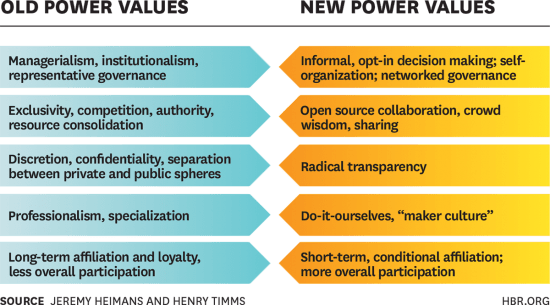Jeremy Heimans and Henry Timms explain the difference between old and new power in the latest issue of the Harvard Business Review.
“Old power works like a currency. It is held by few. Once gained, it is jealously guarded, and the powerful have a substantial store of it to spend. It is closed, inaccessible, and leader-driven. It downloads, and it captures.”
“New power operates differently, like a current. It is made by many. It is open, participatory, and peer-driven. It uploads, and it distributes. Like water or electricity, it’s most forceful when it surges. The goal with new power is not to hoard it but to channel it.”
They argue that the battle and the balancing between old and new power will be a defining feature of both society and business in the coming years.
“As new power models become integrated into the daily lives of people and the operating systems of communities and societies, a new set of values and beliefs is being forged. Power is not just flowing differently; people are feeling and thinking differently about it. A teenager with her own YouTube channel engages as a content creator rather than as a passive recipient of someone else’s ideas. A borrower on the peer-to-peer finance platform Lending Club can disintermediate that oldest of old power institutions, the bank. A Lyft user experiences consumption as a kind of sharing and subtly shifts his view of asset ownership.”
“These feedback loops—or maybe we should call them ‘feed-in’ loops, given that they’re based on participation—make visible the payoffs of peer-based collective action and endow people with a sense of power. In doing so, they strengthen norms around collaboration and make the case that we can do just fine without the old power middlemen that dominated the 20th century.”
Heimans explained the concept of new power in a very interesting TED Talk.

